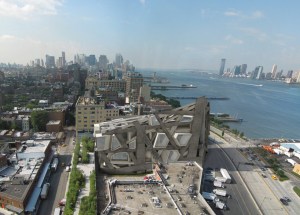Architect Provocateur Redesigns Renzo, Dings Developers
By Matt Chaban September 22, 2010 11:02 pm
reprints Last year, John Beckmann and some designers at his firm Axis Mundi decided they were fed up with the proposal for Jean Nouvel’s MoMA Tower. “Hines and MoMA have been jamming this down everyone’s throat,” Mr. Beckmann told the Architect’s Newspaper at the time. His solution: Design his own version of the tower, an ironic, pop art pastiche with a Jenga-like construction. The proposal drew quite a bit of attention–in no small part because it was much shorter, though not smaller, than Mr. Nouvel’s, clocking in at 50 stories instead of 82. (Perhaps he was on to something as they were later cut down to size by the City Planning Commission.)
Last year, John Beckmann and some designers at his firm Axis Mundi decided they were fed up with the proposal for Jean Nouvel’s MoMA Tower. “Hines and MoMA have been jamming this down everyone’s throat,” Mr. Beckmann told the Architect’s Newspaper at the time. His solution: Design his own version of the tower, an ironic, pop art pastiche with a Jenga-like construction. The proposal drew quite a bit of attention–in no small part because it was much shorter, though not smaller, than Mr. Nouvel’s, clocking in at 50 stories instead of 82. (Perhaps he was on to something as they were later cut down to size by the City Planning Commission.)
The real reason it was so shocking to the design community, though, is because this is just something you don’t do, go redesigning other people’s buildings. It’s a faux pas, to say the least. And Axis Mundi is at it again.
Mr. Beckmann has launched his latest attack this week, striking out at the Whitney’s new High Line museum and its architect Renzo Piano (another Pritzker winner). “I just think it’s so kneejerk, the way these institutions and boards make these decisions,” Mr. Beckmann said from New Hampshire, where he is spending a month at the McDowell Art Colony.
“With Piano, he’s just become the go-to guy for these sorts of projects,” Mr. Beckmann added. “You know what you’re gonna get, the classic Parthenon-on-the-hill building, and I don’t think it’s right for that site.” (New Yorkers may know Mr. Piano from his work at the Morgan Library, the new New York Times building, and Columbia’s proposed Manhattanville campus.)
Perhaps with a proposal like this, would Mr. Beckman like to design a museum of his own? “Eli Broad didn’t call me and say he’s reconsidering Diller Scofidio,” the architect admitted. At first he said that the purpose of these projects was not to win new work–the firm’s doing fine, thank you very much, having just started on a 6,000-square-foot apartment on the Upper West Side and finishing up a few others–or to attract attention. Later on in the conversation, he reconsidered. “Do we want to get noticed? Of course. Besides, it can’t hurt,” Mr. Beckmann said. It’s a very Web 2.0 approach to architecture.
But it could backfire. At least one prominent New York City architect thinks so:
“Particularly when there are so many architects creating innovative, daring projects (for actual clients that they have) which will, for a variety of reasons, remain unbuilt, it seems odd to believe that you can distinguish yourself by creating alternate designs for projects that you don’t have. I could see if there was a social purpose to it- for example to demonstrate positive social good with an alternate design. But if the point is simply to attract attention to yourself, that seems inappropriate. Also, I don’t think it is going to get work (at least with savvy clients). Better to invent a project and pitch that- and there are certainly some pressing problems out there which cry out for designs.”
Mr. Beckmann said if he “ruffles a few feathers,” so be it! “I think the architecture profession is incredibly conservative. So yeah, in a way, I’m striking a poker into it. But really, some of these people are so boring. Maybe we’re taking a risk, but I think it’s worth it.” Amen, brother!
It’s true that the profession also has a long history of theoreticians and agitators, from Hugh Ferriss to Venturi Scott Brown, from Superstudio to Raimund Abraham. Sadly what unifies such designers is there relative lack of built projects, despite their vision. (The derisive term paper architect was coined for the very purpose of describing such designers.)
Whether Mr. Beckmann’s agressively self-promotional style–and architecture–can succeed remains to be seen. Especially if his own predictions come true. “Everyone’s at the mercy of the developers, especially in New York City, which doesn’t have very many enlightened developers,” he said. “I think, coming out of this recession, it’s going to be very bad in terms of good design. There will be no risks taken anymore.”
Good luck with all that.


